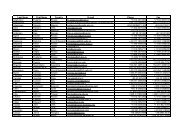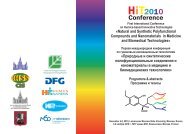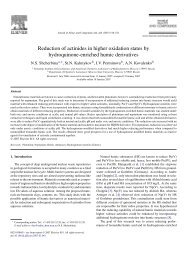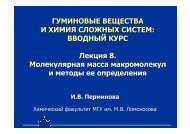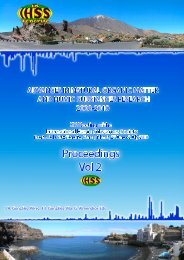- Page 1 and 2: Volume I From Molecular Understandi
- Page 3 and 4: Dedication to the memory of Profess
- Page 5 and 6: Organizing Committee Lunin, Valery,
- Page 7 and 8: Preface The 20 th century was the c
- Page 9 and 10: Dear colleagues and friends of humi
- Page 11 and 12: On behalf of the International Unio
- Page 13: On behalf of the Government of Mosc
- Page 16 and 17: Insights into the Composition of Hu
- Page 18 and 19: Section II - Natural organic matter
- Page 20 and 21: Distribution of Water Soluble Organ
- Page 22 and 23: Comparison of 13 C NMR Spectra of F
- Page 24 and 25: Effect of Humic Substances on Metal
- Page 26 and 27: Hybrid Sorbents on the Basis of Mag
- Page 28 and 29: Structural Components and Biologica
- Page 30 and 31: The Effect of Bioaugmentation on th
- Page 33: Agent-Based Modeling of Natural Org
- Page 37 and 38: Probing Local pH in Hydrophobic Dom
- Page 39 and 40: In each experiment, the intensity o
- Page 41 and 42: Study on Self-Assembling Mechanism
- Page 43 and 44: 3. RESULTS AND DISCUSSION HRUS has
- Page 45 and 46: Multiple Charged Constituents in Su
- Page 47 and 48: supermixtures. Although we have to
- Page 49 and 50: Depicting Molecular Dissimilarity i
- Page 51 and 52: Molecular level precision analytica
- Page 53 and 54: Isolation and Characterization of H
- Page 55 and 56: -10 net proton surface excess, mmol
- Page 57 and 58: Hydrous Pyrolysis of Natural Organi
- Page 59 and 60: a) b) Time (min) 10 20 30 40 50 60
- Page 61 and 62: High Resolution and Hyphenated Anal
- Page 63 and 64: mixtures - molecular inventory need
- Page 65 and 66: X-Ray Spectromicroscopy of Organic
- Page 67 and 68: Figure 1. Transmission X-ray micros
- Page 69 and 70: Effects of pH, Temperature, and Org
- Page 71 and 72: Figure 1. a) Dissolution curves of
- Page 73 and 74: Spectroscopic Evaluation of Charcoa
- Page 75 and 76: Table 1. Ratios of the measured UV-
- Page 77 and 78: Properties of Hydration Shell of IH
- Page 79 and 80: from that ice which was attributed
- Page 81 and 82: Insights into the Composition of Hu
- Page 83 and 84: Figure 2. 13 C Bloch Decay NMR spec
- Page 85 and 86:
Characterization of Soil Organic Ma
- Page 87 and 88:
Table 2. The Alkyl-C/O-Alkyl-C rati
- Page 89 and 90:
Characterization of Chernozem Humic
- Page 91 and 92:
The DRIFT spectra of humic fraction
- Page 93 and 94:
Autodock Simulation of Interactions
- Page 95 and 96:
Structural Characteristics of Soil
- Page 97 and 98:
3.3. Thermal properties of HMi and
- Page 99 and 100:
A Water Soluble Polymer as a Workin
- Page 101 and 102:
Leonardite HA Synthetic HA Absorban
- Page 103 and 104:
Characterization of Humic Acids fro
- Page 105 and 106:
Random Generation of 3D Structures
- Page 107 and 108:
Biodegradation of Humic Acid by Whi
- Page 109 and 110:
non-exchangeable protons shown in T
- Page 111 and 112:
Limitations in High Resolution NMR
- Page 113 and 114:
Investigation of Chemical Structure
- Page 115 and 116:
1037, 1375; lower ones at m/z 537,
- Page 117 and 118:
Spectral Characterization of Plant-
- Page 119 and 120:
DOM sources were primarily composed
- Page 121 and 122:
Capillary Electrophoresis and Fluor
- Page 123 and 124:
2). Component 1 was most sensitive
- Page 125 and 126:
Characterization of Synthetic (Core
- Page 127 and 128:
Magnetic Field Laboratory in Tallah
- Page 129 and 130:
High Resolution Ultrasonic Spectros
- Page 131 and 132:
40 35 30 25 N (1/m) 20 15 10 5 0 -5
- Page 133 and 134:
Characterization of Mumijo (Shilaji
- Page 135 and 136:
Extraction and Characterisation of
- Page 137 and 138:
possible aggregating compounds, suc
- Page 139 and 140:
Measuring Soil Amino Compounds by A
- Page 141 and 142:
individual amino compounds (Table 1
- Page 143 and 144:
Membrane Processes Applied to the S
- Page 145 and 146:
3. RESULTS AND DISCUSSION The resul
- Page 147 and 148:
Studies of the Structure of Extract
- Page 149 and 150:
Figure 3. The XRD pattern. Figure 4
- Page 151 and 152:
Application of a Novel Polarity Met
- Page 153 and 154:
1.00 0.90 0.80 Retention Coefficien
- Page 155 and 156:
Separation and Isolation of Soil Hu
- Page 157 and 158:
uffer at a level 1%. Urea assists i
- Page 159 and 160:
NMR Approaches for Characterization
- Page 161 and 162:
structure and functionality among t
- Page 163 and 164:
Comparison of Humic Acid and Metal
- Page 165 and 166:
The negative area after the hump in
- Page 167 and 168:
Comparison of Mumijo (Shilajit) and
- Page 169 and 170:
Solid Phase Micro Extraction (SPME)
- Page 171 and 172:
3. RESULTS AND DISCUSSION Our first
- Page 173:
Section II Natural organic matter a
- Page 176 and 177:
Many methods of soil chemistry (suc
- Page 178 and 179:
5. ACKNOWLEDGMENTS RFBR grant № 0
- Page 180 and 181:
etween 1893 and 1900 i.e. Kozlovski
- Page 182 and 183:
2. MATERIALS AND METHODS Lake water
- Page 184 and 185:
System a Depth Season Type of syste
- Page 186 and 187:
egion, absorption at 1384 cm −1 ,
- Page 188 and 189:
may lie in the ultrafiltration beha
- Page 190 and 191:
during the first 3 days. As indicat
- Page 192 and 193:
4. SUMMARY AND CONCLUSIONS Our stud
- Page 194 and 195:
• Certain biomacromolecules are o
- Page 196 and 197:
other fossil fuels). These hydrates
- Page 198 and 199:
and 6607 ± 79 yr at 50-100 cm. Aci
- Page 200 and 201:
Table 2. The dynamics of analytical
- Page 202 and 203:
as minimally dependent on climatic
- Page 204 and 205:
Table 1. The carbon species content
- Page 206 and 207:
3. RESULTS AND DISCUSSION Paramagne
- Page 208 and 209:
calibrated against KCl and Radiomet
- Page 210 and 211:
4. CONCLUSIONS Increased frequency
- Page 212 and 213:
and solid state 13 C-CPMAS-NMR usin
- Page 214 and 215:
of these groups revealed the domina
- Page 216 and 217:
each plot soil was sampled from the
- Page 218 and 219:
Microbial species for test were ind
- Page 220 and 221:
4. CONCLUSIONS The results of FT-IR
- Page 222 and 223:
degraders using the natural organic
- Page 224 and 225:
4. CONCLUSIONS The results showed a
- Page 226 and 227:
whole soil and the HF treated sampl
- Page 228 and 229:
Table 1. Sample depth, C and N valu
- Page 230 and 231:
3. RESULTS AND DISCUSSION Chemical
- Page 232 and 233:
in TL spectrum of P-HA sample, whic
- Page 234 and 235:
Humic and fulvic acids were separat
- Page 236 and 237:
An important role in determining so
- Page 238 and 239:
The number of plots found for each
- Page 240 and 241:
Table 1. T50 for DTG. Data are mean
- Page 242 and 243:
Histosols for both layers 0-25 and
- Page 244 and 245:
Cambisols 27,6% Acrisols 0,1% Chern
- Page 246 and 247:
2 ml) at room temperature for 16 ho
- Page 248 and 249:
lipid composition occured. On the o
- Page 250 and 251:
abandoned about 30 years ago; 4 pin
- Page 252 and 253:
4. CONCLUSIONS C associated to the
- Page 254 and 255:
m). In each soil sample pH (H 2 O a
- Page 256 and 257:
main fraction in E and EB horizons,
- Page 258 and 259:
0 5 depth in cm 10 15 20 average C3
- Page 260 and 261:
REFERENCES 1. Steinbeiss, S., Beßl
- Page 262 and 263:
Conductivity and pH was determined
- Page 264 and 265:
REFERENCES 1. Aiken G.R. 1985. Isol
- Page 266 and 267:
MAS) 13 C NMR spectra were obtained
- Page 268 and 269:
REFERENCES 1. Shoji, S., Nanzyo, M.
- Page 270 and 271:
Table 1. Distribution of size fract
- Page 272 and 273:
Relative fluorescence intensity Hum
- Page 274 and 275:
water extract) used in this study.
- Page 276 and 277:
Table 1. Some related information a
- Page 278 and 279:
iomass, they utilize remnants of th
- Page 280 and 281:
mg l -1 CU 4 3 2 1 0 4 2 Colour DOC
- Page 282 and 283:
ACKNOWLEDGEMENT We thank the resear
- Page 284 and 285:
temperature (T) and conversion (α)
- Page 286 and 287:
showed a sudden increase in kinetic
- Page 288 and 289:
CL -1 in 0,02 M NaHCO 3. Degree of
- Page 290 and 291:
indices of HA are greatly influence
- Page 292 and 293:
solutions of alpha-radioactive elem
- Page 294 and 295:
and RF Ministry of Education and Sc
- Page 296 and 297:
analysis standard methods were used
- Page 298 and 299:
environment can be improved only wi
- Page 300 and 301:
Table 1. Characteristics of Lake V
- Page 302 and 303:
DOC, mg/L a CDOM (254) A250/A360 F(
- Page 304 and 305:
2. MATERIALS AND METHODS The resear
- Page 306 and 307:
A soil system passes the irreversib
- Page 308 and 309:
method, whereas sterols were purifi
- Page 310 and 311:
3. RESULTS AND DISCUSSION For the m
- Page 312 and 313:
3. RESULTS AND DISCUSSION In a gene
- Page 314 and 315:
4. CONCLUSIONS All the FTIR, DRUV-V
- Page 316 and 317:
3. RESULTS AND DISCUSSION Variabili
- Page 318 and 319:
4. CONCLUSIONS 1. The diverse granu
- Page 320 and 321:
ESI FT-ICR mass spectra were acquir
- Page 322 and 323:
The first autumn storm, beginning 1
- Page 324 and 325:
4. CONCLUSIONS DOC, DON, SUVA and T
- Page 326 and 327:
Sample NaPT d = 1.6 Sonication Cent
- Page 328 and 329:
A number of aromatic compounds have
- Page 330 and 331:
The Gumat-80 preparation (“Gumat
- Page 332 and 333:
BRHE Program; Grant of “Molecular
- Page 334 and 335:
3. RESULTS AND DISCUSSION In this s
- Page 336 and 337:
of the key parameters describing po
- Page 338 and 339:
The formula of Determan (Determan,
- Page 340 and 341:
that the process of humification wi
- Page 342 and 343:
HF. The humic fractions were charac
- Page 344 and 345:
unaltered plant debris, BC and alip
- Page 346 and 347:
3. RESULTS AND DISCUSSIONS Decompos
- Page 348 and 349:
Initial recoveries of new C within
- Page 350 and 351:
25-30 % from the contents of the no
- Page 352 and 353:
REFERENCES 1. Gorbunov, N. I. 1963.
- Page 354 and 355:
3. RESULTS AND DISCUSSION Elemental
- Page 356 and 357:
whereas the HAL from the P series e
- Page 358 and 359:
Emission spectra were recorded over
- Page 360 and 361:
The EEM spectra of HALs (Figure 2)
- Page 362 and 363:
amounts of organic sulfur, up to 14
- Page 364 and 365:
The FA samples were isolated and pu
- Page 366 and 367:
Alkyl-C (1), (2) proportions in the
- Page 368 and 369:
degree of aromaticity (6) and molec
- Page 370 and 371:
REFERENCES 1. Kalbitz, K., Geyer, S
- Page 372 and 373:
elative lignin content of fresh tis
- Page 374 and 375:
4. CONCLUSIONS The debris of pine f
- Page 376 and 377:
2. MATERIALS AND METHODS Soil surve
- Page 378 and 379:
REFERENCES 1. Saparov A. S. 2007. S
- Page 380:
The CO 2 evolved was trapped by 0.5



